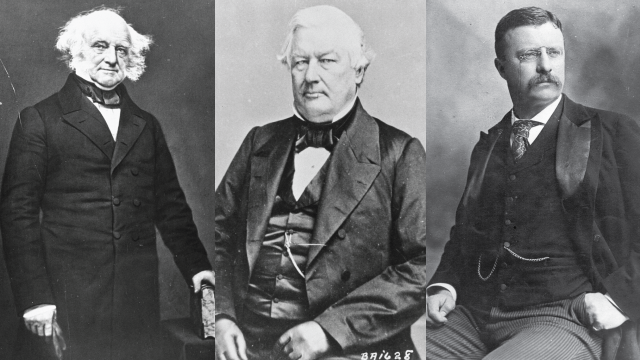
Regardless of whether he succeeds or not, Donald Trump’s decision to seek the White House again in 2024 puts him among a small group of ex-presidents who have subsequently run for elective office.
Grover Cleveland is the only former president who has ever come back after being defeated for reelection to win a second nonconsecutive term. Cleveland, a Democrat from New York, won a narrow victory in 1884 but lost in the Electoral College in 1888 despite winning the popular vote. Cleveland was renominated in 1892 and decisively beat Benjamin Harrison – the man he had lost to four years earlier.
We consulted a number of presidential history sites in researching this post, including the White House Historical Association, the National Constitution Center and the University of Virginia’s Miller Center. Historical election results were taken from the University of California, Santa Barbara’s American Presidency Project.
Ulysses S. Grant served two full presidential terms from 1869 to 1877 and, despite urgings from some in the Republican Party, declined to seek what would have been an unprecedented third term in 1876. But four years later, he changed his mind and sought the Republican nomination again. Although he led the field for nearly the entire GOP convention, Grant couldn’t win over a majority of the delegates to secure the nomination and ultimately lost to James A. Garfield on the 36th ballot. (Grant’s third run was possible because the two-term limit for presidents was a tradition, rather than a rule, until Franklin D. Roosevelt won four straight elections between 1932 and 1944. The 22nd Amendment, limiting the president to two terms, was ratified in 1951.)
Herbert Hoover never quite got over his landslide loss to FDR in 1932. He made concerted efforts to rebuild his influence within the Republican Party and, he hoped, regain the presidency. After waging a behind-the-scenes battle for the GOP nomination in 1936 against Alf M. Landon (the ultimate Republican nominee), Hoover made a more overt effort in 1940. But although convention delegates seemed to receive Hoover warmly, there was little enthusiasm for actually nominating him again: The former president received just 17 votes on the first ballot, far behind the leading candidates, and was never truly a contender.
Three other former presidents have sought to regain their old offices, all on third-party tickets and all unsuccessfully:
- Martin Van Buren lost his reelection bid in 1840, but eight years later made a comeback attempt as the nominee of the antislavery Free Soil Party. He came in a distant third, with about 10% of the popular vote and no electoral votes.
- Millard Fillmore, Zachary Taylor’s running mate, succeeded Taylor when he died 16 months into his presidential term. Fillmore sought the nomination of his Whig Party for a full term in 1852 but lost to Winfield Scott (who lost the general election). Four years later, Fillmore was nominated as the American (or “Know-Nothing”) Party’s presidential candidate. Fillmore finished third with 21.6% of the popular vote, but won only Maryland’s eight electoral votes.
- Theodore Roosevelt succeeded to the presidency in 1901 after William McKinley’s assassination. After serving nearly all of what would have been McKinley’s second term, Roosevelt won a full term of his own in 1904. Afterward, Roosevelt promised not to run for another term – a pledge he came to regret, especially after he grew dissatisfied with the performance of his hand-picked successor, William Howard Taft. In 1912, Roosevelt reversed himself and sought the Republican nomination again, but lost to Taft. He then formed his own Progressive (or “Bull Moose”) Party and ran as its nominee. Roosevelt ran the strongest third-party campaign to date, placing second in both the popular (27.4%) and electoral (88) votes.
In addition, after wrapping up the Republican presidential nomination in 1980, Ronald Reagan seriously considered picking former President – and former Vice President – Gerald Ford as his running mate. But Ford reportedly was less than enthusiastic about returning to the VP spot, and Reagan eventually cooled on the idea, naming George H.W. Bush instead.
Four other ex-presidents had post-presidential political careers, of varying lengths and degrees of success:
- James Madison and James Monroe were both elected delegates to the 1829-1830 Virginia constitutional convention. Monroe presided over the convention until ill health forced him to step aside.
- Two years after losing his reelection bid to Andrew Jackson, John Quincy Adams became the first – and so far only – former president to run for and win a U.S. House seat. Adams held the seat from 1831 to 1848, when he had a stroke at his desk on the House floor and died two days later in the Speaker’s Room.
- In 1841, John Tyler became the first vice president to succeed to the presidency on his predecessor’s death, but his single term in office was less than a rousing success. Nearly two decades later, Tyler was elected to Virginia’s secession convention, and then to the Provisional Confederate Congress. In November 1861 he was elected to the Confederate House of Representatives, but he died in January 1862 before he could take his seat.
- After surviving his impeachment trial in 1868, Andrew Johnson left the White House and returned to his native Tennessee. But Johnson remained interested in elective office, running unsuccessfully for a U.S. Senate seat in 1869 and a House seat in 1872. Finally, in 1875, Johnson was chosen as a senator from Tennessee, but he died less than five months into his term.
